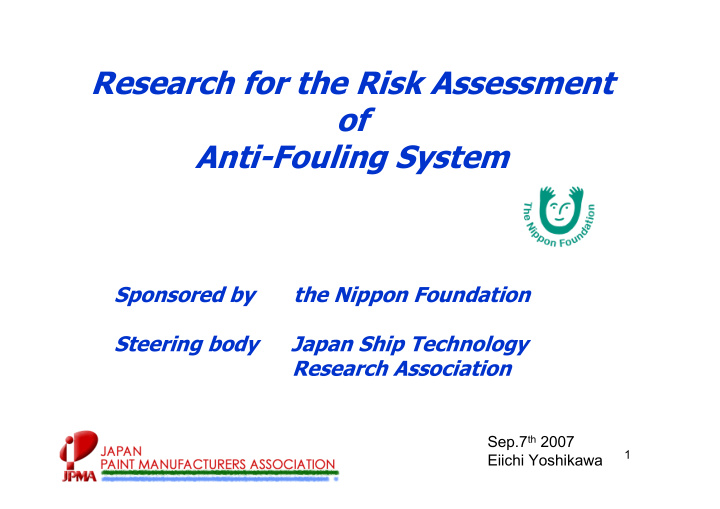



Research for the Risk Assessment of Anti-Fouling System Sponsored by the Nippon Foundation Steering body Japan Ship Technology Research Association Sep.7 th 2007 1 Eiichi Yoshikawa
International activity of chemical management History • Agenda 21 : adopted in1992 at World summit • Inter-governmental Forum On Chemical Safety : Set up in 1994 • Strategic Approach to International Chemicals Management (SAICM) : adopted in 2006 at Dubai. 2
International activity of chemical management SAICM 国際的化学物質管理戦略 Sub-title : Comprising the Dubai Declaration on International Chemicals Management, the Overarching Policy Strategy and the Global Plan of Action . Objectives: Risk reduction Knowledge and information Governance Capacity-building and technical cooperation Illegal international traffic 3
International activity of chemical management SAICM Chemical Risk reduction By the year 2020, chemicals are produced and used in ways that minimize significant adverse impacts on the environment and human health 4
International activity of chemical management SAICM is progressing for the risk reduction by 2020 • Pesticides : Regulatory systems have been introduced or strengthened • High Concern substances : POPS/Heavy metals/CMR substances : Mostly prohibition • Existing chemicals : EU : implemented REACH in 2007. Registration, Evaluation, Authorisation and Restriction of Chemicals Japan: Plan to revise the chemical control law to review the life-cycle of all existing chemicals. 5
The objectives of REACH is protection of human health and the environment Preparation Substance Article Notification/ Registration Notification/ Registration Registration Evaluation or Authorization But… Ships can go through without REACH regulation. MSDS 6
International activity of chemical management Conclusion It is going toward throughout control of entire life cycle including products and articles containing chemicals. How about ships? IMO responds • On ship recycling to minimize the hazardous waste • Chemical use for Ballast tank (G8 ) • Antifouling system (AFS treaty) 7
IMO Resolutions with AFS Convention • Resolution 2: The Conference invites States to approve, register or license anti-fouling systems applied in their territories, bearing in mind the information contained in Annex 3 of the Convention. • Resolution 3: The Conference urges States to continue the work, in appropriate international forum, for the harmonization of test methods, assessment methodologies, and performance standards for anti-fouling systems containing biocides. 8
Why ISO standard? Marine has no borders. The assessment should be harmonized. To respond to AFS treaty in Resolution 2 & 3, need a harmonized tool to judge acceptable AF systems. ISO is an appropriate forum to discuss such a global issue. 9
The risk assessment covers the service life after leaching active substances. Deposition Volatilization Aerosol UV Degradation Leaching Biological Hydrodynamic Degradation Hydrolysis transport Speciation Sorption to - tide, currents particlate matter - density (S) Bioaccumulation - river flux Sediment Settling 3 species toxicity and Partitioning Burial Biological Degradation 10
Scope of Risk Assesment Environmental Risk assessment Safety & Leaching rate E-fate studies ↓ ↓ Exposure scenario Hazard characterization For service life ↓ Decides UF ↓ PEC calculation ↓ PNEC calculation paint AIs PEC/PNEC Persistency, Bioaccumulation Judgments & Decision 11
The scheme Japan is considering. AI’s profile Tier1 Low bioaccumulation (BCF<100) Accept Readily degradation ( HL<15days) (+ 3 acutes & 1chronic, Degradation, fish accumulation) PEC/PNEC<1 $0.3M Not accepted Tier 2 BCF<100 & HL<60days Level 1 Or Tentatively Accept* BCF<1000 & HL<15days (+2 chronics+ Sediment accumulation) PEC/PNEC<1 $0.3M * But must go Level2 within ( )years Level2 (+ Metab. of natural water) Accept PEC/PNEC<1 (+if necessary, food chain access) Overall low risk $1-0.5M 12
• ISO TC8/SC2 NWIP • Due to harmonize the risk assessment and the safety studies, hope that each of countries will join the WG of ISO TC8/SC2. End. -ISO project- 13 Standard for Marine Environment risk assessment for AF
Recommend
More recommend